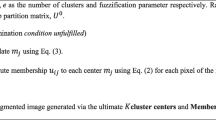Abstract
In this paper, we propose a new method for construction of distance functions and metrics, by applying aggregation operators on some given distance functions and metrics. For some types and examples of aggregation operators, we analyze which properties of the given distance functions and metrics are preserved by such construction. We also present one possible application of the distance functions constructed in such way in image segmentation by fuzzy c-means algorithm. Other similar applications in image processing are also possible.








Similar content being viewed by others
Notes
Could be considered as functions whose codomain is \([0,\infty ]\) also.
Or distance function.
References
Bezdek JC, Ehrlich R, Full W (1984) Fcm: the fuzzy c-means clustering algorithm. Comput Geosci 10(2–3):191–203
Chang HH, Zhuang AH, Valentino DJ, Chu WC (2009) Performance measure characterization for evaluating neuroimage segmentation algorithms. NeuroImage 47(1):122–135
Deza MM, Deza E (2009) Encyclopedia of distances. Springer, Berlin
Dombi J (1982) Basic concepts for a theory of evaluation: the aggregative operator. Eur J Oper Res 10:282–293
Dubois D, Prade H (2004) On the use of aggregation operations in information fusion processes. Fuzzy Sets Syst 142(1):143–161
Grabish M, Marichal JL, Mesiar R, Pap E (2009) Aggregation functions. Cambridge University Press, Cambridge
Klement EP, Mesiar R, Pap E (2000) Triangular norms. Springer, Netherlands
Klir GJ, Yuan B (1995) Fuzzy sets and fuzzy logic, theory and applications. Prentice Hall, New Jersey
Martin D, Fowlkes C, Tal D, Malik J (2001) A database of human segmented natural images and its application to evaluating segmentation algorithms and measuring ecological statistics. In: Proceedings of the 8th international conference on computer vision, vol 2, pp 416–423
Acknowledgements
First and second authors acknowledge the financial support of the Ministry of Education, Science and Technological Development of the Republic of Serbia, in the frame of Project applied under No. TR 34014. Second author acknowledge the financial support of the Ministry of Education, Science and Technological Development of the Republic of Serbia, in the frame of Project applied under No. TR 174009.
Author information
Authors and Affiliations
Corresponding author
Ethics declarations
Conflict of interest
The authors declare that they have no conflict of interest.
Ethical approval
This article does not contain any studies with human participants or animals performed by any of the authors.
Additional information
Communicated by V. Loia.
Rights and permissions
About this article
Cite this article
Nedović, L., Ralević, N.M. & Pavkov, I. Aggregated distance functions and their application in image processing. Soft Comput 22, 4723–4739 (2018). https://doi.org/10.1007/s00500-017-2657-9
Published:
Issue Date:
DOI: https://doi.org/10.1007/s00500-017-2657-9




